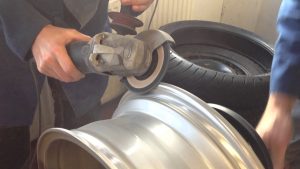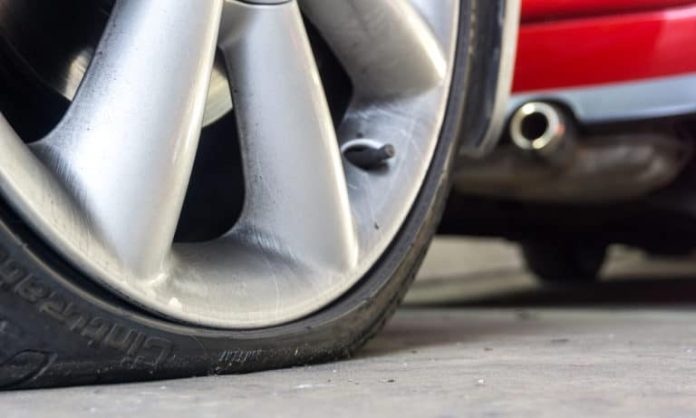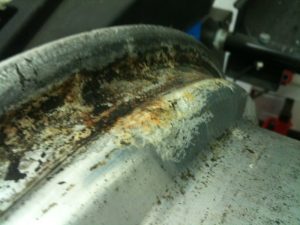Have you had the problem of a tire that won’t hold air? It doesn’t go flat outright, just slowly – as the air bleeds out over time. You may not even notice it until it’s almost flat, because it takes a keen eye to be able to tell by looking that a modern, short sidewall tire that is supposed to be inflated to 40 psi is only holding 22 psi.
Many people don’t look – much less check – because they have been conditioned to rely on their car’s tire pressure monitoring system to let them know (via a light in the gauge cluster) when a tire is running low. These tire pressure monitoring system have been federally required for many years now, in the wake of the Ford Explorer/Firestone tire debacle, which you may remember. People drove their Explorers on under-inflated tires at high speeds; the resultant tire failure resulting in barrell-rolling Explorers and a number of injuries and deaths.
The tire pressure monitoring systems were supposed to correct the problem of people not checking their tire pressure and driving around on dangerously under-inflated tires (low air pressure increases friction which causes increased heat build-up and that can lead to tire failure; under-inflated tires also affect handling/braking performance).
The problem is the “check tires” warning light that’s supposed to motivate people to check their tires’ inflation pressure is regularly ignored, in part because the light not uncommonly comes on when the tire pressure is fine. After a while, people stop paying attention to it – even if it’s on all the time.
But why are the tires losing air?
It may not be for the usual reasons, such as a nail in the tread. It is now common for sound-seeming tires to just slowly lose air for no apparent reason. It is not uncommon, when this happens, to have to manually check the tires every week or two – which people ought to be doing regardless – and fill the tires back up to the specified pressure. Which they ought to not have to do, unless there is a nail in the tread or some other kind of damage to the tire or the valve stem.
What there is, on the other hand, is corrosion on the bead surface of the wheel. This is a common problem with the aluminum wheels almost all new cars now come standard with (and have come standard with since roughly the early 2000s). Aluminum wheels have a number of virtues, the chief one being they’re much lighter than steel wheels and that lowers the curb weight of the vehicle as well as decreases rolling resistance, both of which improve fuel economy and performance. Aluminum wheels are also attractive; they can be cast in all kinds of different styles and – unlike the plastic hubcaps that used to come with steel wheels – they don’t lose their hubcaps in the curves.
But they do corrode.
And that is why your tires may be leaking air.
It’s not the tires’ fault at all. The problem is that the seal between the tire and the wheel isn’t air-tight, on account of the corrosion that built up on the wheel that the shop you paid to install the tires didn’t grind off the wheel. The reason they didn’t being it takes effort and time and that detracts from getting your car in and out of the shop as quickly as possible.
Now it’s on you to make sure you’re not driving around on under-inflated tires. The problem is you probably will, because it’s easy to forget to check (and fill) a tire that is constantly losing air. Inevitably, you’ll drive around for awhile with it down five, maybe ten pounds – or even more. Then it will wear unevenly or more quickly – and when you try to get warranty action, the tire store will deny it and tell you it’s all you’re fault because you abused the tire by not maintaining proper inflation pressure!
This is why it’s good to know about aluminum wheel corrosion – and what it does unless the corrosion is removed before a new tire is installed.
. . .
If you like what you’ve found here please consider supporting EPautos.
We depend on you to keep the wheels turning!
Our donate button is here.
If you prefer not to use PayPal, our mailing address is:
EPautos
721 Hummingbird Lane SE
Copper Hill, VA 24079
PS: Get an EPautos magnet or sticker or coaster in return for a $20 or more one-time donation or a $10 or more monthly recurring donation. (Please be sure to tell us you want a magnet or sticker or coaster – and also, provide an address, so we know where to mail the thing!)
If you like items like the Keeeeeeev T shirt pictured below, you can find that and more at the EPautos store!













Hi Eric,
Thanks for a reminder about corrosion. It’s huge problem in damp climate, and where a lot of salt is used on roads in winter. But flat tires can also be caused by bent wheels. When the air temperature goes low, a tire on a bent wheel may go flat.
On a separate (but related) note, I wonder what you think about keeping cars in warms garages in winter? I understand that this is what you folks usually do in your country. Isn’t this a problem for a car when it is regularly taken out and and then back in, cooling it and then warming it back up, over and over again? Doesn’t it do bad things to cars, like materials fatigue from contraction/expansion and corrosion of electric parts (from condensation)?
Good morning, Yuri!
In my experience, keeping a car in a garage makes a huge difference in terms of retarding deterioration. Especially in areas where the car would otherwise be subjected to extremes of heat and cold, as well as be exposed to more rain/snow, etc. I have a 22-year-old truck that still looks like it’s six years old; it has very little rust. I don’t baby it like I do my old Trans-Am. But I do keep it garaged!
I swear by garages. I cannot help but think that my old car has lasted so long because of the garage. Nothing is nicer than knowing the ice and now will melt off in the Winter after a storm because it is parked inside away from the elements.
Eric,
Agreed about garages, but my question was rather about whether warm garages are worse than cold ones, in winter.
Hi Yuri,
I think an attached garage is probably ideal. The temperature range within (especially in winter) will be closer to “room temp” and (my evaluation here) this is better (easier on) rubber and plastic than extreme and sustained cold. The car will also dry off more quickly when parked and ice/snow won’t stick around for long.
Eric,
Thanks for your reply. My guess would be it’s better to have a stable temperature environment rather than avoid low temperatures, but that’s just a guess and I haven’t seen any studies on this. So temperature controlled garage is probably ideal.
Hi Yuri,
I’m not aware of any studies but I can relay my own extensive experience. My garage isn’t temperature controlled, per se. As in, it’s not heated (or cooled). But because it is attached to the house and insulated, it never gets very cold even when it is very cold outside. And in summer, the cars are shielded from the beating-down sun as well as such things as heavy, continuous rain. I used to have a ’98 Frontier essentially identical to my ’02 that I still own. I sold the ’98 a few years back because it was beginning to suffer serious frame rust. It was parked outside. My ’02 has always been garaged and the thing has only superficial rust. It also has still-shiny paint and the interior doesn’t look 22 years old, either!
I can vouch for the leaky aluminum wheel issue – My Chevy Cobalt, which I drive for most of it’s 225,000 (only a third northern Wisconsin deer finally killed it,) would leak pretty bad. New sets of tires every few years would slow the leaks, but they were always there. Filled them up ’bout once a week. Obviously, the days during the winter where the high temperature would get to a balmy -40 degrees didn’t help matters lol.
I have rarely had an issue with slow leaks except if they have been caused by leaks in the tires.
All that said, I find the TPMS systems on cars to be annoying and useless.
By the time you get a warning, you are usually flat.
I put the blame on all of this squarely on Ford Motor Company.
They put said Firestone tires on their Explorer, which at the time, was a Ranger pickup with an SUV body. Coupled with a 4.0L 6 cylinder motor developing 160 hp, they were pressed into duty in the early 1990s. Although their powertrain was otherwise unremarkable, they shared suspensions with the Ranger pickup truck, a rough riding small pickup designed for tradesman. To assist in “ride comfort” Ford recommended a dangerously low 26 psi for their tires. Other cars with the exact same tires did not have the issue as their recommended pressures were higher and the trucks lighter.
Ford had to have known what they are doing by recommending a tire pressure a 4 year old could blow into a balloon.
Bridgestone/Firestone should have immediately recalled their tires and called Ford to the mat for this fiasco. Of course, the bureaucrats at the NHTSA must have worked overtime to come up with their supposed solution 12 years after the Ford-Firestone debacle took place.
Now, we have the most inane crap known as TPMS, a system that works intermittently at best and annunciates false positives when it comes to tire pressure.
Also this is an issue on motorcycle cast wheels with tubeless tires, and/or residue from old tire mounting. Had a buddy that bought a motorcycle tire changer, had him do my third set of tires for the old Harley. So, he shows me the residue buildup from the prior two sets of tires that was never cleaned off. The fix (these were not corroded just gunk) was to use a wad of fiberglass window screen. In just a few minutes he had all the gunk removed without scratching the metal rim. A bad bead seal on a scooter could really ruin your day!
When having the tires rotated they were going to charge me a fortune to simply tell the ECM the new locations. I told them to never mind as I had marked the tires their original position. If the machine says Right Front I look for the wheel marked Right Front even though it may be on the Left Rear.
As for air pressure, if its cold I top it a little lower,,, 30 vs 32. Hot, a little higher, 34 vs 32.
Off Topic,,, it seems the French gov have passed a new law regarding taking ‘vaxxines’. Refuse. Go to jail for 3 years,,, 45,000 Euro fine. Even better…. if your a doctor or a scientist and have proof the vaccine is detrimental to your life or will cause miserable diseases, again, go to jail if they release the information. By and By, the pharmacies and pharmaceutical companies cannot be sued no matter what.
It appears voting and/or protesting won’t work this next go around. At least for Frenchy.
https://www.paulcraigroberts.org/2024/02/18/french-democracy-establishes-medical-tyranny/
Wow Ken,
That’s just crazytown. I’ve always admired the French for refusing to go along with the Chimp’s Iraq misadventure; looks like now it’s time for the peasants to dust off the guilluetine.
One exception…migrants…illegals…
They are not injected because only citizens are covered in the immunity agreement big pharma has with the government….
Plus the replacement slaves must be healthy when they replace the existing injected slaves, in the cull….
More exemptions….politicians, people in the court system,…judges……all the slave owners of course….and some others
You can purchase the device to update the tire location for about $20.
Worked at a tire shop back in the day…
Had an irate customer complain that we overinflated her new tires on her Explorer. I check…Nope, 35psi all around just like is printed on the tire.
She pulls out her owner’s manual and shows me Ford recommended “26psi max”.
Firestone caught hell over what was in fact was Ford dangerously under inflating their tires.
I replaced the aluminum wheels on my 2007 Envoy with steel rims. Problem solved.
The daughter’s Acura MDX had this problem. I hand refinished the bead surfaces using a 3M Scotchbrite pad used for BBQ grills, about an hour a wheel. This did work but when the corrosion gets bad there can be permanent pits as well, fortunately these pits weren’t big enough to prevent a good seal.
Another leak area is the TPMS sensor mount. Corrosion in the wheel opening here too. Also note there are very specific inch lb torque specs for the sensor stem nut, I had supplied the replacement sensors to the tire shop several years back. When I removed them to clean they were barely finger tight. I also used Hylomar sealant when I remounted the sensors and torqued to spec with my inch lb torque wrench. HYLOMAR AT YOUR OWN RISK! I’ve used it on non turning oring mounts in the past (Harley pushrod tube orings) and found it doesn’t eat orings BUT this isn’t on the approved instructions for TPMS sensor install. Also note the ‘09 Acura recognizes the aftermarket sensors in about two blocks driving no dealer reset required.
You could remove heaviest corrosion from bead seat then put 100ml of Stan’s sealant in the tire. After inflation rotate the assembly in all 3 dimensions to allow sealant into remaining leakage. It will seal your tire.
I had this exact problem on my car. Tire pressure was low, and would steadily decline over a month. I spoke to a repair shop and they speculated corrosion was the problem…and it was. It was fairly expensive to have the wheels sanded, but as I recall, the tires were so old that I needed a new set so the wheels got sanded as “part of the package”.
Another problem with TPS systems is moisture in the air system causing semi-false readings on cold mornings. If your (or the tire store’s) air system doesn’t have desiccant in the line you’ll get water in the tire. No big deal until it gets cold and condenses faster than dry air, leading to an under-pressure reading until the tires warm up. The main advantage to using “nitrogen” in your tires is that it shouldn’t have any water at all.
The other PITA about TPS is if you’re off-roading and lower the tire pressure to get a little (or a lot) more traction. My Cherokee chimes all day when I’m out in the woods, very annoying.
Aaah yes, that happens to my newer vehicle. First one I have ever had that has a “tire nanny”, as I call it. It never fails: The temperatures dip down to the -20 below zero and colder, and that stupid tire light turns on. Of course the tires are going to lose a bit of air going from a warm garage, and then sitting outside in the frigid Winter temperatures for the day. Square tire anyone? I just find the things to be more of an annoyance than the are worth. But thankfully, mine does not chime at me. Now that would really drive me up a wall.
Chrome plating on aluminum wheels appears to exacerbate the problem. I was even told so by a tire tech when I gave up on the chrome plated aluminum wheels and took it to a tire shop. Fortunately, I soon had a spare set of wheels from changing tires and wheels on my Miata, which perfectly fit on the 02 Mazda Protege with new tires. Problem solved.
Aluminum alloy wheels stick to the hub, if you have a flat on the road, loosen the lug nuts on the wheel and drive a little ways, the wheel will release from the hub. It is a problem, a three pound maul will do it too. Just bang on the wheel from the inside, it should loosen.
You’re standing there wondering why the wheel is stuck to the hub, corrosion does it. Have to change the flat, vehicle’s up on the scissor jack, but the wheel won’t budge. Stuck, you need a bigger hammer. Been there, done that, just so you know. You run over a two inch 3/8th bolt on the road, the tire goes flat. You have to stop, no other choice. Have to make the change, can’t be in the middle of nowhere, you are in big trouble then. Gotta be moving with the groove.
The local junkyard is always buying discarded aluminum alloy wheels, separating them from the rest of the other metals makes aluminum great again.
Hi drumpish,
Had the same problem on one of my cars, needed a sledgehammer to get the wheel loose. After that I took off each wheel and smeared grease on all the mating surfaces; no problem since.
Another method is to loosen all your lug nuts till their just clear of the rim by a turn or so and turn the steering wheel back and force while diving slowly. This method works if you don’t have a large mallet handy.
The front wheels will break loose first and the rear wheels will take longer.
‘corrosion on the bead surface of the wheel … is a common problem with the aluminum wheels’ — eric
This problem, and the slow pressure loss it caused, has driven me nuts on several aluminum-wheeled non-TPMS vehicles, including my 1998 Nissan Frontier which sheds about 4 psi per month.
I have a set of steel wheels for it and may just switch them out. Yes, aluminum is superior to reduce unsprung weight. But until something can be done about bead corrosion, aluminum also sucks pretty bad as a wheel material.
Some aluminum wheels I had on a 1992 Acura started to shed their clear coating and develop nasty-looking random splotches of oxidation. Who needs that crap?
The problem I had with the only TPMS system I ever owned was its wild inaccuracy. As much as 5 pounds off. Or more.
I’ve replaced the worn/broken TPMS with plain rubber valve stems on my Wrangler. When I asked my local tire center about TPMS replacements, they said that they do not fool with them because they have to be reprogrammed at a Stealership and was looking at a $100 plus per wheel. So now I live with the low tire light and carry a gauge. $14 bucks vs $100+, easy choice!
I don’t know your dash layout, but a piece of black tape could solve that light problem.
I did the same thing when one of my valve stems broke, got a rubber one installed. I always check the tire pressure every week or so anyway, and as John Kable said, small piece of black tape covers up the annoying light.